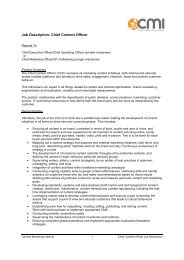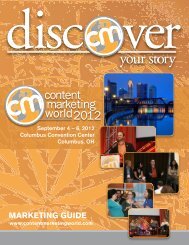Download Now - Content Marketing Institute
Download Now - Content Marketing Institute
Download Now - Content Marketing Institute
You also want an ePaper? Increase the reach of your titles
YUMPU automatically turns print PDFs into web optimized ePapers that Google loves.
How to Choose Technology that Drives Better <strong>Content</strong> <strong>Marketing</strong> ResultsKeep the customer’s experience in mindDavid Raab suggests starting by documenting the customer engagement strategy, specifically the processes through which the organizationneeds to walk a prospective buyer. As Carlos Hidalgo points out, most B2B organizations are selling to multiple buyers within targetaccounts and it’s vital to develop an understanding of their roles, functions, challenges, and the triggers that move them towards a buyingdecision. Without this understanding, any technology could, potentially, be the wrong technology since it will not get marketers any closerto a meaningful connection with prospects.Account for data continuityAccording to Adam Needles, it’s critical to determine what it takes to ensure continuity of the information associated with prospective buyers— including their lead status — as the data follow the prospect from stage to stage. Without this mapping, organizations will fail to tapinto all the data they’re collecting.First, break the process down by stages in the buying (or selling) cycle and by the content to be delivered at eachstage. Next, determine the data that need to be added and passed on at each stage to effectively engage, nurture,and convert prospects. Don’t forget to outline what downstream processes, such as lead handoff, look like from thesales perspective. By thinking through the step-by-step process, marketers will understand what’s needed to ensurecontinuity from beginning to end while avoiding adding complexity.Consider:• What’s your business?• What’s your product or service?• Who are your customers?• What does the buying/sales cycle look like?• What systems are in place for data sources (CRM, marketing automation, web analytics, etc.)?• What’s the size of your data stores, number of customers, and quantity of process workflows?8





